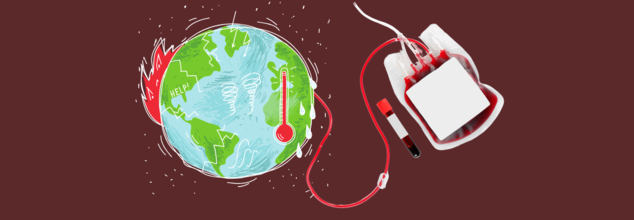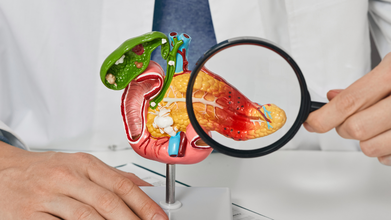- Health Conditions A-Z
- Health & Wellness
- Nutrition
- Fitness
- Health News
- Ayurveda
- Videos
- Medicine A-Z
- Parenting
Is Climate Change Draining The World's Blood Banks?

In the aftermath of a global pandemic, with the memory of oxygen shortages still fresh and the threat of new infectious diseases looming large, the world's healthcare systems are stretched thinner than ever. We're battling overlapping health crises- resurging malaria and dengue cases, the global spread of West Nile virus, new strains of flu, antibiotic-resistant infections, and a growing mental health epidemic. Public health is in constant firefighting mode but there is one quiet casualty of this mad world that seldom hits the headlines—our blood supply.
Blood—so simple, so essential—lies at the very center of modern medicine. Whether it's stabilizing a trauma victim, sustaining a cancer patient through chemotherapy, or enabling women to survive complicated delivery, the presence of safe, screened, and timely blood transfusions is not negotiable. And yet, today, that lifeline is being quietly and methodically disrupted.
As global warming picks up, it is progressively eating away at all levels of the blood supply chain—donor health to storage conditions to transportation logistics. Intense heatwaves deter donors, electricity failures weaken storage refrigeration, and flooding or forest fires slow blood unit delivery. Insects that transmit blood-borne illnesses such as dengue and West Nile virus are spreading to new areas as a result of altered weather patterns, complicating and accelerating blood screening. In short, what was once a relatively predictable system is now under attack from unpredictable climatic events.
This isn't a remote threat—it's occurring today. A recent study in The Lancet Planetary Health cautions that climate change may compromise the safety, adequacy, and availability of blood supplies around the world. Investigators have demanded proactive measures: additional mobile and versatile blood collection units, enhanced disease monitoring, and global cooperation to maintain resilience against environmental shocks.
Behind all the science and statistics stands a human narrative: a father in need of blood following a car accident, a child with sickle cell disease, a pregnant woman. Their lives are not only dependent upon donors, but upon a system powerful enough to withstand the floods—literally.
As the planet's climate crisis gains speed, its effect is no longer limited to melting glaciers or sea level rise—it now runs in our veins, literally. The integrity of the global blood supply is becoming a vital, under-covered casualty of global warming. With millions depending on secure blood transfusions for surgeries, trauma, cancer treatment, and the control of chronic disease, interruptions to the blood supply chain can be disastrous for public health systems globally.
From shifting donor supply to jeopardizing storage and transportation logistics, climate change is quietly mounting pressure on every step along the blood supply chain and with the planet warming up, so does the imperative for health systems to do the same.
Blood is the foundation of emergency care and chronic patient management. Over 25 million units of blood are transfused every year in Europe alone, treating victims of accidents, premature babies, and patients with diseases such as sickle cell disease and cancer but providing a steady, clean supply of blood involves a precarious balance of infrastructure, logistics, and volunteer donors.
This equilibrium is increasingly disrupted by climate-related disturbances—severe heat, floods, storms, and disease outbreaks—that affect everything from donor engagement to safe blood transportation and storage.
How Climate Events Disrupt the Blood Supply?
Severe weather events like hurricanes, floods, wildfires, and heatwaves are becoming more frequent and intense, directly impairing the capacity to obtain, test, store, and distribute blood products. Such events can physically destroy facilities, restrict staff and donor mobility, or lead to spontaneous spikes in demand because of injury.
Natural disasters not only disrupt transportation and storage but also reduce the pool of available donors, said Red Cross Lifeblood and University of the Sunshine Coast (UniSC) Australian Australia's Dr. Elvina Viennet. "These events upset the storage, safety, and transport of blood, which has a limited lifespan," she said.
The effect is not hypothetical; when hurricane Harvey struck in the US, for example, hundreds of blood drives were canceled, creating regional shortages. In these emergencies, there is frequently a simultaneous and urgent rise in demand for blood and fall in supply—a health system's worst nightmare.
Increased rainfall and global warming have pushed the geographical limits of vector-borne illnesses such as dengue, malaria, and West Nile virus—some of which are transmissible through blood. Ideal breeding conditions for mosquitoes are promoted by warmer climates, which makes transfusion-transmissible infections (TTIs) a matter of concern.
"Climate change could affect some blood-borne infectious diseases that can exclude individuals from donating," Viennet said. This complicates and costs more to screen blood, overloading already stressed health systems.
Europe has already seen an increase in dengue cases previously unusual in the region illustrating the speed at which new threats are arising because of changes in the environment.
Donor Health and Availability in a Changing Climate
Aside from infectious diseases, climate change can also have a direct impact on donor health. Heat, air pollution, dehydration, and cardiovascular stress can decrease the number of eligible donors. Even minor physiological changes—such as changes in haemoglobin levels due to heat—can disqualify donors.
There is also a mental health angle to consider where climate anxiety, post-disaster trauma, and stress from displacement can reduce donor participation. The study pointed to increased anxiety and depression among both donors and healthcare workers in the aftermath of extreme weather events.
As climate change worsens chronic conditions—specifically cardiovascular and respiratory disease—it also raises demand for blood transfusions. Complications of pregnancy, sickle cell crises, and surgeries can become more common, adding demand-side pressure to blood banks.
This combined risk of dwindling supply and escalating demand is not abstract; it's already materializing. Left unchecked, health systems could soon experience catastrophic care gaps.
Ways to Protect Blood Supplies in a Warming World
To combat this impending crisis, scientists and policymakers recommend a multi-faceted strategy:
- Mobile and flexible blood donation facilities that can function during and after severe weather conditions.
- Global cooperation to exchange blood supplies across borders during scarcity.
- Research investment to learn how climate factors affect donor health and blood stability.
- Implementation of cell salvage methods (autotransfusion) in operating rooms to minimize dependence on external blood supply.
Increased diversity donor recruitment, particularly from migrant communities, to more closely match rare blood groups and meet altered demographics.
As UniSC's Dr. Helen Faddy pointed out, "With sea levels rising and migration rates growing, it's critical to have a greater number of blood donors from diverse ethnicities."
The blood supply is not only a technical problem—it's a human one. While climate change continues to test the world's health systems, protecting our blood supply has to be an absolute priority. The danger is multiple- biological, logistical, psychological, and infrastructural like the climate crisis itself, it requires global action, scientific innovation, and urgent, sustained effort.
Early Warning Signs of 'Silent Killer' Cancer: Study Finds Symptoms That Could Help Early Diagnosis

(Credit-Canva)
Pancreatic cancer is widely known as a "silent killer" because it doesn't usually cause pain or noticeable issues until it is very advanced and hard to treat. This is why doctors and researchers are always searching for earlier signs. Fortunately, new research has uncovered a possible warning sign that could help find the disease much sooner. Detecting this cancer early, when it is small and hasn't spread, gives patients the best chance for a successful recovery.
Why Is Pancreatic Cancer Difficult To Diagnose?
The statistics for pancreatic cancer show just how deadly it is. Even though it makes up a small percentage of all cancer cases (around 3%), it is responsible for a large number of cancer deaths (about 8%).
This high death rate happens because the cancer is often only found after it has already spread to other organs in the body. When cancer is found late, the chance of survival is very low—only about 3% to 16% of people live for five years or more. Because of these low survival rates, finding a dependable way to spot this cancer early is absolutely essential to saving more lives.
Early Sign of Pancreatic Cancer
Researchers at Johns Hopkins University School of Medicine have discovered a promising sign that might point to early cancer: the pancreatic duct is enlarged. The pancreatic duct is basically a tube that carries the digestive juices out of the pancreas.
In their study, published in the journal Gastro Hep Advances, the research team found that if this duct is swollen or enlarged, it suggests a much higher risk of developing pancreatic cancer. This sign is particularly important for people who already have a high chance of getting the disease due to family history or genetics.
The researchers studied 641 people who were already considered to be at a high risk for pancreatic cancer, either because close family members (like parents or siblings) had it, or because they had specific genes that increase the danger.
Key Discovery: They found that 97 of these high-risk patients had this enlarged pancreatic duct.
Increased Odds: When they tracked these patients, they found that those with the duct enlargement were 2.6 times more likely to eventually get pancreatic cancer compared to the people without the enlargement. The danger was even greater if they had the enlarged duct and three or more fluid-filled sacs, called cysts, on their pancreas.
Will This Increase Pancreatic Cancer Survival Rate?
This discovery gives doctors a clear signal to take action. If a doctor sees an enlarged pancreatic duct on a medical scan—even if the scan was initially ordered for a different issue, like checking for kidney stones or general belly pain—they should immediately treat it as a warning sign.
Next Steps
The action taken would be to either perform very frequent and detailed imaging (scans) to watch the area closely, or in some cases, do surgery to remove the tissue concerned.
Can This Improve Chances Of Diagnosis?
Dr. Canto pointed out that sometimes, the swelling in the duct is visible even before the cancerous mass itself is big enough to be clearly seen on a scan. This means doctors have a valuable new chance to step in earlier than ever before.
The research is not stopping here; the team’s next big project is to teach Artificial Intelligence (AI) how to look at pancreas scans. The goal is for the AI to analyze the images and make even more specific and accurate predictions about a person's risk of developing pancreatic cancer.
Do We Have A Safe Amount Of Using Toothpaste? This Is What A Dentist Revealed

Credits: Canva
Most toothpaste commercials show a long, dramatic swirl covering the entire length of the toothbrush. But dentists say this is not only misleading, it could actually be harmful.
A video shared by Dr. Miles Madison, Beverly Hills Periodontist & Dental Implant Specialist, has sparked fresh debate on how much toothpaste is truly safe. Paired with expert insights and existing dental research, one message is clear: more toothpaste does not mean better cleaning.
The Big Problem: We’re Using Far More Toothpaste Than Needed
According to Dr. Madison, almost 40% of people use an excessive amount of toothpaste, as shown by CDC findings. The amount typically seen in commercials? “That much is a hell no,” he says.
His guidance on the correct amount is straightforward:
For Babies and Toddlers (Teeth Eruption to Age 3)
Use only a smear, roughly the size of a grain of rice.
This tiny amount protects the teeth without overexposing children to fluoride, especially since young kids often swallow toothpaste instead of spitting it out.
For Ages 3 and Above
Use a pea-sized amount no more.
This is enough to clean the teeth thoroughly without increasing health risks.
Why Using Too Much Toothpaste Is Harmful
Children under eight have teeth and gums that are still developing. Overusing toothpaste, particularly fluoride-containing toothpaste, can trigger dental fluorosis, a condition caused by excess fluoride intake. This results in yellow or white spots, enamel damage, pits, and an increased risk of cavities.
Because children tend to swallow toothpaste, larger amounts can quickly push them into unsafe fluoride levels.
Adults Aren’t Exempt From Risks Either
Even though adults are less likely to swallow toothpaste, using too much can still:
- Erode protective enamel over time
- Irritate gums
- Trigger sensitivity
- Leave residue that traps bacteria
- Encourage people to brush too aggressively
Dentists also warn that people often rely too heavily on toothpaste while neglecting brushing technique — gentle circular motions, not force, and flossing.
So What Does Toothpaste Actually Do?
Toothpaste works by:
- Breaking down plaque
- Fighting bacteria
- Strengthening enamel
- Reducing inflammation
- Neutralizing acids
- Freshening breath
However, its benefits peak at a pea-size amount. Beyond that, the risks outweigh the rewards.
The Safe Brushing Routine Dentists Recommend
- Use only the recommended amount for your age
- Choose a fluoride toothpaste unless advised otherwise
- Use a soft-bristled brush
- Brush for two minutes
- Spit out the foam; don’t rinse immediately for long-lasting fluoride protection
- Floss daily
- Supervise young children while brushing
Used correctly, toothpaste prevents cavities, gum disease, and tooth loss, but used excessively, it can do more harm than good.
Not Stage 1, 2, 3, or 4: But There Is Another Stage Of Breast Cancer That Only A Scan Can Detect, According To An Australian Surgeon

(Credit-Canva)
Highlighting the importance of getting screened, surgeon Christine Lai reveals a key stage of breast cancer that most people do not know about.
Breast cancer is one of the leading cancer diagnoses for women throughout the world. But it is also a highly treatable type of cancer if found early. While most of us know that breast cancer symptoms like lumps in the breast or discharge from the nipples, these symptoms come when the cancer is already progressing to an advanced stage.
The University of Kansas Cancer Center explains that there could be a palpable lump or tenderness, but generally breast cancer has no symptoms in the early stage. But is this stage 1, or stage 2? Which early stage cannot be accurately diagnosed with self-examination.
In a recent post, Dr Christine Lai, Specialist Surgeon based in Australia, details the key stage people do not know about and its not 1 or 2, its stage 0.
What is Stage 0 Of Breast Cancer?
Dr Lai explains that stage 0 is the very first and most treatable stage of breast cancer. At this point, no actual lump has formed, and the person usually has no symptoms.
The cancer cells are only sitting inside the milk ducts, where they are growing but have not yet developed the ability to break out and spread into the surrounding breast tissue.
This specific type of cancer is often called Ductal Carcinoma In Situ (DCIS). If we find cancer at this stage, it is almost certainly curable. This is why getting a routine screening mammogram is so crucial—it can catch this hidden stage and save a life.
What Are The Other Stages Of Breast Cancer And Their Treatability?
In the video, Dr Lai details how big the tumor is during each stage, and how is it different from the previous stage, along with their treatability.
Stage 1: A Small, Localized Tumor
Stage 1 cancer means the tumor is quite small and is mostly confined to the breast. The tumor is usually 2 cm or less in size, which is smaller than a cherry. At this point, the cancer either hasn't spread to the lymph nodes at all, or the spread is extremely minimal and only visible under a microscope. Because the cancer is so small and localized, Stage 1 is highly treatable.
Stage 2: Moderately Sized or Starting to Spread
Stage 2 means the cancer is either moderately sized or has started to involve a few nearby lymph nodes. This stage applies if the tumor is smaller than 5 cm but has spread to up to three lymph nodes. It also applies if the tumor is larger than 5 cm but hasn't yet spread to any lymph nodes at all. Think of this as the cancer becoming more established, either by growing larger in one spot or starting to spread slightly to the closest glands.
Stage 3: Advanced Local and Regional Cancer
Stage 3 indicates that the cancer has become more aggressive locally, involving more lymph nodes or invading nearby tissues. This applies if there are more than three involved lymph nodes, or if the tumor is invading the chest wall or the skin of the breast. A special type of cancer called inflammatory breast cancer is also classified as Stage 3 because of how it spreads across the breast tissue. This stage requires more intensive treatment because the disease has spread more extensively in the chest area.
Stage 4: Spread to Other Body Parts (Metastatic)
Stage 4 is when the breast cancer has spread from the breast and armpit to distant parts of the body, such as the bones, lungs, liver, or brain. This is also known as metastatic breast cancer. While this stage is generally not curable, it is still highly treatable. Treatment focuses on controlling the cancer, relieving symptoms, and allowing the patient to maintain the best possible quality of life.
© 2024 Bennett, Coleman & Company Limited

